Journal Description
Kinases and Phosphatases
Kinases and Phosphatases
is an international, peer-reviewed, open access journal on every aspect of post-translational modifications in all biological systems, from bacteria to humans, covering a wide range of disciplines, including biochemistry, molecular biology, structural biology, cell biology, medicinal chemistry, pharmacology, cellular pathology, and clinical disciplines, and is published quarterly online by MDPI.
- Open Access— free for readers, with article processing charges (APC) paid by authors or their institutions.
- Rapid Publication: manuscripts are peer-reviewed and a first decision is provided to authors approximately 18.5 days after submission; acceptance to publication is undertaken in 2.8 days (median values for papers published in this journal in the first half of 2025).
- Recognition of Reviewers: APC discount vouchers, optional signed peer review, and reviewer names published annually in the journal.
Latest Articles
Past, Present and Future of Protein Kinase CK2 Research
Kinases Phosphatases 2025, 3(3), 17; https://doi.org/10.3390/kinasesphosphatases3030017 - 19 Aug 2025
Abstract
The first described instance of protein kinase activity dates back more than half a century [...]
Full article
(This article belongs to the Special Issue Past, Present and Future of Protein Kinase CK2 Research)
Open AccessReview
Farnesoid X Receptor (FXR) Agonists and Protein Kinase Regulation in NAFLD and NASH: Mechanisms and Therapeutic Potential
by
Ayan Saha, Emily Wood, Luna Omeragic, Maya Minkara, Kethain Marma, Shipan Das Gupta and Jannatul Ferdoush
Kinases Phosphatases 2025, 3(3), 16; https://doi.org/10.3390/kinasesphosphatases3030016 - 11 Jul 2025
Abstract
►▼
Show Figures
Non-alcoholic fatty liver disease (NAFLD) is a common metabolic condition characterized by hepatic lipid deposits, insulin resistance, and inflammation which may progress to non-alcoholic steatohepatitis (NASH) and fibrosis. Protein kinases play an important role in NAFLD development by regulating metabolic and inflammatory pathways.
[...] Read more.
Non-alcoholic fatty liver disease (NAFLD) is a common metabolic condition characterized by hepatic lipid deposits, insulin resistance, and inflammation which may progress to non-alcoholic steatohepatitis (NASH) and fibrosis. Protein kinases play an important role in NAFLD development by regulating metabolic and inflammatory pathways. Mitogen-activated protein kinases (MAPKs), protein kinase C (PKC), AMP-activated protein kinase (AMPK), phosphoinositide 3-kinase (PI3K)/AKT, and mechanistic target of rapamycin (mTOR) are all involved in NAFLD and NASH progression. Emerging evidence indicates that Farnesoid X Receptor (FXR) agonists have therapeutic potential by modulating bile acid metabolism, lipid balance, and inflammatory responses. This review examines the mechanistic interplay between FXR agonists and important protein kinases in NAFLD and NASH. FXR agonists activate AMPK, which promotes fatty acid oxidation and reduces hepatic steatosis. They also regulate MAPK signaling, which reduces c-Jun NH2-terminal kinase (JNK)- and p38 MAPK-mediated inflammation. Furthermore, FXR agonists activate the PI3K/AKT pathway, enhancing insulin sensitivity and modulating mTOR signaling to reduce hepatic fibrosis. Clinical studies in NAFLD/NASH indicate that FXR agonists confer metabolic and anti-inflammatory benefits, although optimizing efficacy and minimizing adverse effects remain challenging. Future studies should focus on combination therapies targeting FXR alongside specific kinases to improve therapeutic outcomes. This review highlights the potential of FXR agonists to modulate protein kinase signaling, opening new avenues for targeted NAFLD/NASH therapy.
Full article

Figure 1
Open AccessArticle
Regulation of Mouse CK2α (Csnk2a1) Promoter Expression In Vitro and in Cell Lines
by
Gregory A. Imbrie, Nicholas G. Wilson, David C. Seldin and Isabel Dominguez
Kinases Phosphatases 2025, 3(3), 15; https://doi.org/10.3390/kinasesphosphatases3030015 - 4 Jul 2025
Cited by 1
Abstract
CK2α is a kinase important for essential cellular and biological processes. CK2α is ubiquitously expressed, albeit at different tissue levels, and its transcript levels are dysregulated in disease. However, there is limited knowledge on the regulation of CK2α gene expression. The best one
[...] Read more.
CK2α is a kinase important for essential cellular and biological processes. CK2α is ubiquitously expressed, albeit at different tissue levels, and its transcript levels are dysregulated in disease. However, there is limited knowledge on the regulation of CK2α gene expression. The best one studied, the human CSNK2A1 (CK2α) gene promoter, contains uncharacterized binding motifs for NF-κB. Our goal was to investigate the role of NF-κB in Csnk2a1 promoter regulation. We cloned the mouse Csnk2a1 promoter which had significant sequence homology with the human CSNK2A1 promoter. Using promoter deletions, we identified a minimal promoter region containing transcription factor motifs (NF-κB, Ets-1, Sp1) consistent with those published for the CSNK2A1 promoter. Electrophoretic mobility shift assays demonstrated specific NF-κB subunit binding to the minimal promoter. NF-κB subunit transfection and extracellular NF-κB stimulation in non-tumor cell lines led to increased transactivation of the mouse minimal promoter. These data, together with data on the regulation of NF-κB by CK2 kinase activity, suggest a positive-feedback loop between CK2α and NF-κB. Non-tumor cell line re-plating and increased percent confluence upregulated Csnk2a1 transcript levels which differed from tumor cell line published data. In summary, Csnk2a1 promoter is regulated by NF-κB signaling and during cellular proliferation.
Full article
(This article belongs to the Special Issue Past, Present and Future of Protein Kinase CK2 Research)
►▼
Show Figures

Figure 1
Open AccessReview
Protein Kinases in Mediating Phage-Bacteria Interactions
by
Yong Everett Zhang
Kinases Phosphatases 2025, 3(3), 14; https://doi.org/10.3390/kinasesphosphatases3030014 - 25 Jun 2025
Abstract
►▼
Show Figures
Protein kinases and phosphatases are essential for post-translational regulation, enabling bacteria to adapt to environmental stresses and modulate virulence. While prior reviews have broadly covered their roles in stress response, antibiotic resistance, and virulence, this article updates specifically on the roles of histidine
[...] Read more.
Protein kinases and phosphatases are essential for post-translational regulation, enabling bacteria to adapt to environmental stresses and modulate virulence. While prior reviews have broadly covered their roles in stress response, antibiotic resistance, and virulence, this article updates specifically on the roles of histidine kinases (HKs) and serine/threonine kinases (STKs) in mediating phage-bacteria interactions. A key aspect is phage-encoded kinases, which hijack bacterial signalling by phosphorylating and disrupting host processes to promote infection. Despite their importance, significant gaps remain in understanding these regulatory networks. This microreview highlights both the unresolved mechanisms and the therapeutic potential of targeting kinase pathways—for instance, by disrupting phage evasion strategies or enhancing phage-based antimicrobial therapies.
Full article

Figure 1
Open AccessArticle
Fucosylation-Mediated Suppression of Lipid Droplet Accumulation Induced by Low-Level L-Fucose Administration in 3T3-L1 Adipocytes
by
Tomoya Nakamura, Tomohiko Nakao, Yuri Kominami, Miho Ito, Teruki Aizawa, Yusuke Akahori and Hideki Ushio
Kinases Phosphatases 2025, 3(3), 13; https://doi.org/10.3390/kinasesphosphatases3030013 - 24 Jun 2025
Abstract
►▼
Show Figures
Obesity causes lifestyle-related diseases such as hypertension and type 2 diabetes and has become a global health concern. L-fucose (Fuc), a monosaccharide that can be derived from brown algae, has been shown to strongly suppress lipid droplet accumulation in 3T3-L1 murine adipocytes at
[...] Read more.
Obesity causes lifestyle-related diseases such as hypertension and type 2 diabetes and has become a global health concern. L-fucose (Fuc), a monosaccharide that can be derived from brown algae, has been shown to strongly suppress lipid droplet accumulation in 3T3-L1 murine adipocytes at high concentrations via the activation of AMP-activated kinase (AMPK). Although low concentrations of Fuc also exhibited similar effects, the underlying mechanisms remain unclear. In this study, we investigated the effects of low-level Fuc on lipid metabolism, focusing on the role of fucosylation. Low-level Fuc did not induce AMPK phosphorylation but suppressed lipid droplet accumulation. This suppressive effect was abolished by co-treatment with the fucosylation inhibitor 2F-Peracetyl-Fucose (2F-PAF), suggesting that fucosylation plays a key role in the observed metabolic regulation. Furthermore, proteomic analysis combined with click chemistry pulldown suggested that proteins involved in the regulation of lipid metabolism, such as acetoacetyl-CoA synthetase enzymes and catalytic subunit alpha of cAMP-dependent protein kinase, are fucosylated or interact with fucose. These findings provide novel insights into the anti-obesity mechanisms of Fuc and highlight the physiological significance of protein fucosylation in adipocyte lipid metabolism.
Full article
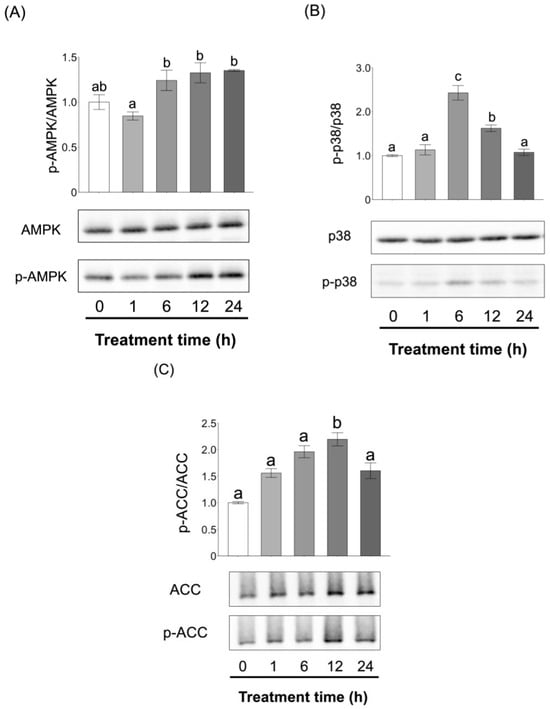
Figure 1
Open AccessReview
The Multifaceted Role of STK35/STK35L1 in Human Diseases: A Time for Critical Appraisal
by
Arpana Yadav, Kritika Gaur, Phulwanti Kumari Sharma, Pragya Gehlot, Saloni Bage, Mahesh Saini, Daniela Brünnert and Pankaj Goyal
Kinases Phosphatases 2025, 3(2), 12; https://doi.org/10.3390/kinasesphosphatases3020012 - 23 May 2025
Abstract
►▼
Show Figures
Dysregulation of protein kinases is associated with developmental defects and various human diseases. The human kinome comprises 518 kinases, including several orphan kinases whose functions remain to be fully characterized. The NKF4 family, which includes STK35L1 and PDIK1L, is one such uncharacterized kinase
[...] Read more.
Dysregulation of protein kinases is associated with developmental defects and various human diseases. The human kinome comprises 518 kinases, including several orphan kinases whose functions remain to be fully characterized. The NKF4 family, which includes STK35L1 and PDIK1L, is one such uncharacterized kinase family. STK35L1, also known as Clik1, was initially identified as a nuclear kinase associated with actin fibers. Subsequent studies have demonstrated that STK35L1 plays critical roles in cellular processes such as cell cycle regulation, migration, angiogenesis, the DNA damage response, and related processes such as spermatogenesis. STK35L1 has also been implicated in various developmental processes and its knockout mice exhibited defects in the testis, ovary, and eye. STK35L1 acts as a central regulator of the fundamental cellular functions, and its dysregulation leads to various diseases. Research has established that STK35L1 regulates tumor growth and proliferation in cancers such as osteosarcoma, colorectal cancer, and acute myeloid leukemia. Notably, it also affects chemosensitivity in colorectal cancer and metabolism in acute myeloid leukemia. Additionally, STK35L1 is crucial for the infection of hepatocytes by Plasmodium sporozoites during the liver stage of Malaria. This review discusses the current understanding of STK35L1, highlighting its role in various diseases.
Full article

Figure 1
Open AccessArticle
A Comparative Kinetic Study on Alkaline Phosphatase Thermal Inactivation in Different Milk Types
by
Anastasia Tzereme, Michalis Koureas, Athanasios Manouras, Eleni Malissiova, Georgia Soultani, Konstantina Poulianiti and Eleni Gogou
Kinases Phosphatases 2025, 3(2), 11; https://doi.org/10.3390/kinasesphosphatases3020011 - 16 May 2025
Abstract
►▼
Show Figures
The European Food Safety Authority (EFSA) has raised concerns regarding the use of alkaline phosphatase (ALP) as a pasteurization marker in non-cow milk due to compositional differences. This study investigates the thermal inactivation kinetics of ALP in six milk species (cow, sheep, goat,
[...] Read more.
The European Food Safety Authority (EFSA) has raised concerns regarding the use of alkaline phosphatase (ALP) as a pasteurization marker in non-cow milk due to compositional differences. This study investigates the thermal inactivation kinetics of ALP in six milk species (cow, sheep, goat, donkey, buffalo and camel) to assess its reliability as an indicator. The thermal inactivation of ALP in different milk types was evaluated by heating samples at 63–75 °C at various times, then measuring residual enzyme activity using a spectrophotometric method. The results revealed a sharp increase in ALP inactivation with rising temperatures, consistent with previous findings on the enzyme’s thermal sensitivity. Notably, donkey milk exhibited the highest ALP inactivation at 72 °C, probably due to lower fat content compared to the rest of milk types studied, while camel milk showed the lowest inactivation rate constant (kT) at 75 °C, highlighting its higher heat resistance compared to bovine milk. These findings highlight potential limitations of using the ALP test to verify pasteurization in non-bovine milk, which is directly linked to microbial safety, as well as the preservation of nutritional and sensory characteristics. This study reinforces the importance of considering milk composition, particularly fat and protein structures, in optimizing pasteurization conditions for diverse milk varieties.
Full article

Figure 1
Open AccessReview
Bruton’s Tyrosine Kinase: A Double-Edged Sword in Cancer and Aging
by
Zahraa Qusairy and Miran Rada
Kinases Phosphatases 2025, 3(2), 10; https://doi.org/10.3390/kinasesphosphatases3020010 - 7 May 2025
Abstract
Bruton’s tyrosine kinase (BTK) is a key signaling molecule involved in both hematological malignancies and solid tumors. In B-cell malignancies such as chronic lymphocytic leukemia (CLL) and non-Hodgkin lymphoma (NHL), BTK mediates B-cell receptor signaling, promoting tumor survival and proliferation, leading to the
[...] Read more.
Bruton’s tyrosine kinase (BTK) is a key signaling molecule involved in both hematological malignancies and solid tumors. In B-cell malignancies such as chronic lymphocytic leukemia (CLL) and non-Hodgkin lymphoma (NHL), BTK mediates B-cell receptor signaling, promoting tumor survival and proliferation, leading to the development of BTK inhibitors like ibrutinib that improve patient outcomes. In solid tumors, BTK isoforms, particularly p65BTK, contribute to tumor growth and therapy resistance, with inhibition showing promise in cancers like colorectal, ovarian, and non-small cell lung cancer. BTK also influences the tumor microenvironment by modulating immune cells such as myeloid-derived suppressor cells and tumor-associated macrophages, aiding immune evasion. BTK inhibition can enhance anti-tumor immunity and reduce inflammation-driven tumor progression. Additionally, BTK contributes to tumor angiogenesis, with inhibitors like ibrutinib showing anti-angiogenic effects. Beyond cancer, BTK is linked to aging, where its modulation may reduce senescent cell accumulation and preserve cognitive function. This review explores BTK’s dual role, focusing on its oncogenic effects and potential impact on aging processes. We also discuss the use of BTK inhibitors in cancer treatment and their potential to address age-related concerns, providing a deeper understanding of BTK as a therapeutic target and mediator in the complex relationship between cancer and aging.
Full article
(This article belongs to the Special Issue Role of Protein Post-Translational Modifications in Cancer: Mechanisms and Therapeutic Opportunities)
►▼
Show Figures

Figure 1
Open AccessReview
Nanotechnology-Based Delivery Systems for Enhanced Targeting of Tyrosine Kinase Inhibitors: Exploring Inorganic and Organic Nanoparticles as Targeted Carriers
by
Yana Gvozdeva
Kinases Phosphatases 2025, 3(2), 9; https://doi.org/10.3390/kinasesphosphatases3020009 - 21 Apr 2025
Cited by 2
Abstract
►▼
Show Figures
Kinase inhibitors are small molecules that block kinase activity and have significant applications in both therapy and diagnostics. Recent studies suggest that these inhibitors hold great potential as targets for treating a range of diseases, including autoimmune disorders, cardiovascular conditions, cancer, and inflammatory
[...] Read more.
Kinase inhibitors are small molecules that block kinase activity and have significant applications in both therapy and diagnostics. Recent studies suggest that these inhibitors hold great potential as targets for treating a range of diseases, including autoimmune disorders, cardiovascular conditions, cancer, and inflammatory diseases like ulcerative colitis. Ongoing research focuses on developing effective carriers for tyrosine kinase inhibitors (TKIs) to enhance treatment outcomes while reducing side effects. The nano-scale drug carriers have demonstrated the ability to encapsulate a wide range of imaging and therapeutic agents, enhancing tumor diagnosis and treatment. Notably, the incorporation of drugs with poor pharmacokinetics into nanocarriers enhances their solubility and stability, offering a renewed opportunity to assess their full therapeutic potential. The entrapped agents can be released in a controlled manner to maintain a specific drug concentration within a treatment framework or triggered by specific stimuli such as time or pH to target particular tissues or cells. The multifunctionality of nanosystems offers a promising avenue for developing innovative tyrosine kinase inhibitor (TKI) delivery strategies that serve as alternative treatment options for cancer and other inflammatory diseases. This review aims to provide a comprehensive overview of innovative nano-scale delivery systems for TKIs, both as standalone treatments and in combination with other therapeutic agents or drug delivery approaches. We discuss their comparative advantages and limitations for future small-molecule TKIs research.
Full article

Figure 1
Open AccessReview
Role of Histone Deacetylases in Drug-Resistant Melanoma: Mechanisms and Therapeutic Implications
by
Bhuvanesh Sukhlal Kalal
Kinases Phosphatases 2025, 3(2), 8; https://doi.org/10.3390/kinasesphosphatases3020008 - 21 Apr 2025
Abstract
Melanoma, known for its aggressive nature and propensity for developing drug resistance, remains a significant clinical challenge. The emergence of resistance to both targeted therapies (like BRAF/MEK inhibitors) and immunotherapies is a major obstacle to achieving durable responses and improving patient survival. HDACs,
[...] Read more.
Melanoma, known for its aggressive nature and propensity for developing drug resistance, remains a significant clinical challenge. The emergence of resistance to both targeted therapies (like BRAF/MEK inhibitors) and immunotherapies is a major obstacle to achieving durable responses and improving patient survival. HDACs, a class of epigenetic enzymes, modulate gene expression and chromatin structure by removing acetyl groups from histone and non-histone proteins. In melanoma, aberrant HDAC activity contributes to resistance through multiple mechanisms. HDACs influence key oncogenic signaling pathways frequently dysregulated in melanoma, such as the MAPK, PI3K/AKT, and WNT/β-catenin cascades. By altering the activity of these pathways, HDACs promote the survival and proliferation of melanoma cells even in the presence of therapy. Beyond their direct effects on tumor cells, HDACs also play a crucial role in shaping the tumor microenvironment. They can suppress anti-tumor immune responses by reducing immune cell infiltration, modulating cytokine production, and fostering an immunosuppressive milieu. This further contributes to resistance to immunotherapies. Given the central role of HDACs in these resistance mechanisms, HDAC inhibitors (HDACis) have emerged as potential therapeutic agents to restore drug sensitivity. HDACis can induce cell death, inhibit proliferation, and enhance immune responses in melanoma cells. Preclinical and clinical studies have explored the combination of HDACis with existing therapies to overcome resistance. While promising, the clinical application of HDACis is accompanied by challenges, including toxicity, the need for biomarkers to predict response, and the optimization of combination strategies. Ongoing research is dedicated to developing more selective and potent HDACis and to better understand how to effectively incorporate them into melanoma treatment regimens. This review provides a comprehensive overview of the multifaceted ways in which HDACs contribute to melanoma drug resistance and discusses the potential of HDAC-targeted therapies to improve patient outcomes.
Full article
(This article belongs to the Special Issue Role of Protein Post-Translational Modifications in Cancer: Mechanisms and Therapeutic Opportunities)
►▼
Show Figures
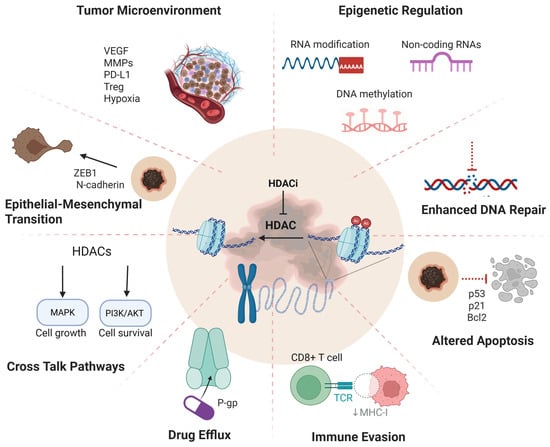
Figure 1
Open AccessReview
Epigenetic Rewiring of Protein Kinase Signalling in T-Cell Acute Lymphoblastic Leukaemia
by
Claudina A. Pérez-Novo, Amber Driesen, Maaike Van Trimpont, Claudia Theys, Emilie Logie, Pieter Van Vlierberghe and Wim Vanden Berghe
Kinases Phosphatases 2025, 3(2), 7; https://doi.org/10.3390/kinasesphosphatases3020007 - 12 Apr 2025
Abstract
T-cell acute lymphoblastic leukaemia (T-ALL) is an aggressive neoplastic malignancy characterised by the accumulation of multiple oncogenic and epigenetic alterations in haematopoietic T-cell precursors leading to their uncontrolled proliferation and accumulation in the bone marrow. For many years it has been established that
[...] Read more.
T-cell acute lymphoblastic leukaemia (T-ALL) is an aggressive neoplastic malignancy characterised by the accumulation of multiple oncogenic and epigenetic alterations in haematopoietic T-cell precursors leading to their uncontrolled proliferation and accumulation in the bone marrow. For many years it has been established that the occurrence of activating mutations, alterations in transcription factors expression, impairment in cell cycle regulators, and hyperactivation of NOTCH1 signalling play prominent roles in the pathogenesis of this disease. Recently, the introduction of high-resolution screening and next-generation sequencing platforms revealed that T-cell progenitors accumulate additional mutations, affecting protein kinase signalling, protein translation, and epigenetic control mechanisms, providing novel attractive targets for therapy. While the contributions of direct genomic events are well understood as causative agents of hyperactive kinase signalling pathways, the epigenetic rewiring of kinase signalling cascades via DNA methylation, histone post-translational modifications, and non-coding miRNAs remains less well explored. In this review, we provide novel perspectives on epigenetic regulatory aspects of kinase signalling heterogeneity in T-ALL pathogenesis and therapeutic outcomes.
Full article
(This article belongs to the Special Issue Regulation of Protein Kinase Activities and Associated Protein Structure Prediction Applied to Drug Discovery)
►▼
Show Figures
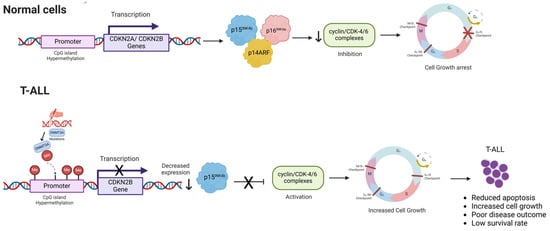
Figure 1
Open AccessEditorial
Editorial: Human Protein Kinases: Development of Small-Molecule Therapies
by
Alison D. Axtman
Kinases Phosphatases 2025, 3(1), 6; https://doi.org/10.3390/kinasesphosphatases3010006 - 19 Mar 2025
Abstract
Human protein kinases are ubiquitously expressed throughout the human body and embedded in signaling pathways that mediate diverse biology [...]
Full article
(This article belongs to the Special Issue Human Protein Kinases: Development of Small-Molecule Therapies)
Open AccessReview
Plant PP2A: A Versatile Enzyme with Key Physiological Functions
by
Juan I. Cortelezzi, Martina Zubillaga, Victoria R. Scardino, María N. Muñiz García and Daniela A. Capiati
Kinases Phosphatases 2025, 3(1), 5; https://doi.org/10.3390/kinasesphosphatases3010005 - 3 Mar 2025
Abstract
►▼
Show Figures
Protein phosphatase 2A (PP2A) is a highly conserved heterotrimeric enzyme complex present in all eukaryotic cells, consisting of a scaffolding A subunit, a catalytic C subunit, and a regulatory B subunit. The A and C subunits form the core enzyme, which interacts with
[...] Read more.
Protein phosphatase 2A (PP2A) is a highly conserved heterotrimeric enzyme complex present in all eukaryotic cells, consisting of a scaffolding A subunit, a catalytic C subunit, and a regulatory B subunit. The A and C subunits form the core enzyme, which interacts with the B subunit to determine the substrate specificity, subcellular localization, and enzymatic activity of the holoenzyme. The Arabidopsis thaliana genome encodes five C subunits, three A subunits, and 17 B subunits, enabling the formation of diverse holoenzymes with extensive functional versatility. Genetic evidence highlights the essential role of PP2A in regulating various physiological processes in plants, including responses to abiotic and biotic stresses and developmental programs. Notably, PP2A can act as both a positive and negative regulator within the same pathway, while individual subunits often participate in multiple processes. This functional diversity arises from the structural flexibility of PP2A. This review examines the structural diversity of plant PP2A and its regulatory roles across diverse physiological contexts.
Full article
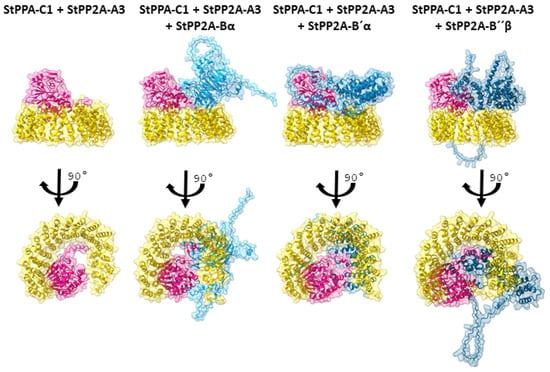
Figure 1
Open AccessArticle
Potential Involvement of Protein Phosphatase PPP2CA on Protein Synthesis and Cell Cycle During SARS-CoV-2 Infection: A Meta-Analysis Investigation
by
Luca P. Otvos, Giulia I. M. Garrito, Gabriel E. Jara, Paulo S. Lopes-de-Oliveira and Luciana E. S. F. Machado
Kinases Phosphatases 2025, 3(1), 4; https://doi.org/10.3390/kinasesphosphatases3010004 - 18 Feb 2025
Abstract
►▼
Show Figures
Coronavirus disease 2019 is a multi-systemic syndrome that caused a pandemic. Proteomic studies have shown changes in protein expression and interaction involved in signaling pathways related to SARS-CoV-2 infections. Protein phosphatases play a crucial role in regulating cell signaling. In this study, we
[...] Read more.
Coronavirus disease 2019 is a multi-systemic syndrome that caused a pandemic. Proteomic studies have shown changes in protein expression and interaction involved in signaling pathways related to SARS-CoV-2 infections. Protein phosphatases play a crucial role in regulating cell signaling. In this study, we assessed the potential involvement of protein phosphatases and their associated signaling pathways during SARS-CoV-2 infection by conducting a meta-analysis of proteome databases from COVID-19 patients. We identified both direct and indirect interactions between human protein phosphatases and viral proteins, as well as the expression levels and phosphorylation status of intermediate proteins. Our analyses revealed that PPP2CA and PTEN are key phosphatases involved in cell cycle and apoptosis regulation during SARS-CoV-2 infection. We also highlighted the direct involvement of PPP2CA in the cell division throughout its interaction with CDC20 protein (cell division cycle protein 20 homolog). This evidence strongly suggests that both proteins play critical roles during SARS-CoV-2 infection and represent potential targets for COVID-19 treatment.
Full article
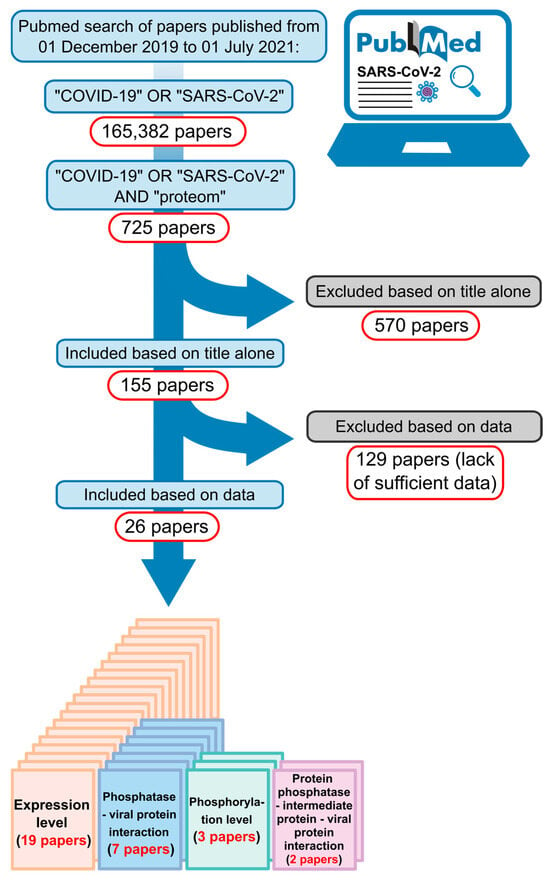
Figure 1
Open AccessReview
Phosphodegrons in Health and Disease: From Cellular Homeostasis to Therapeutic Potential
by
Tadashi Nakagawa and Makiko Nakagawa
Kinases Phosphatases 2025, 3(1), 3; https://doi.org/10.3390/kinasesphosphatases3010003 - 6 Feb 2025
Cited by 1
Abstract
►▼
Show Figures
Phosphodegrons are critical motifs that play a pivotal role in the regulation of protein stability and function via phosphorylation-dependent signaling pathways. These motifs serve as recognition elements for ubiquitin ligases, facilitating the targeted degradation of proteins. By modulating key cellular processes such as
[...] Read more.
Phosphodegrons are critical motifs that play a pivotal role in the regulation of protein stability and function via phosphorylation-dependent signaling pathways. These motifs serve as recognition elements for ubiquitin ligases, facilitating the targeted degradation of proteins. By modulating key cellular processes such as cell cycle progression, DNA repair, and apoptosis, phosphodegrons are essential for maintaining cellular homeostasis. Dysregulation of phosphodegrons has been implicated in a wide range of diseases, including cancer and neurodegenerative disorders, highlighting their potential as therapeutic targets. This review provides an overview of phosphodegron functions along with their biological significance in health and disease. Additionally, we discuss current methodologies for studying phosphodegrons and explore emerging trends in their identification and therapeutic targeting. By synthesizing recent advances in the field, this article aims to offer insights into the future directions and challenges in phosphodegron research, ultimately underscoring their importance in cellular regulation and disease pathology.
Full article

Figure 1
Open AccessArticle
Expression of Tribbles Pseudokinase 3 in Prostate Cancers and Its Roles in Cell Cycle Regulation
by
Djamilatou Adom, Jiuhui Wang, Man-Tzu Wang and Daotai Nie
Kinases Phosphatases 2025, 3(1), 2; https://doi.org/10.3390/kinasesphosphatases3010002 - 6 Feb 2025
Abstract
►▼
Show Figures
Tribbles Pseudokinase 3 (TRIB3) is a negative regulator of cellular signaling, particularly the PI3K-Akt and NF-κB pathways. Aberrant TRIB3 expressions have been reported in a number of cancers, but its role in tumor growth and progression remains controversial since both oncogenic and tumor
[...] Read more.
Tribbles Pseudokinase 3 (TRIB3) is a negative regulator of cellular signaling, particularly the PI3K-Akt and NF-κB pathways. Aberrant TRIB3 expressions have been reported in a number of cancers, but its role in tumor growth and progression remains controversial since both oncogenic and tumor suppressive activities have been reported. The goal of this study is to understand the roles of TRIB3 in prostate cancers through bioinformatic queries of public databases and experimental evaluations through gain-of-function and loss-of-function approaches. Here we report that there was increased TRIB3 gene expression with a Z-score over 2, relative to normal samples, in 26% of prostate cancers. Increased TRIB3 expression was associated with increased mutation counts and aneuploidy scores of prostate cancers. Increased TRIB3 expression was also associated with reduced progression-free or disease-free survival of prostate cancer patients. However, our experiments found that increased TRIB3 expression actually had an antiproliferative effect and increased cell cycle arrest at the G2/M phase. Depletion of the endogenous TRIB3 expression enhanced cell proliferation and reduced the level of Cdc25C phosphatase. Our results suggest that although TRIB3 expression was increased in prostate cancers in association with increased genomic instabilities, TRIB3 actually promoted cell cycle arrest and reduced tumor cell proliferation.
Full article
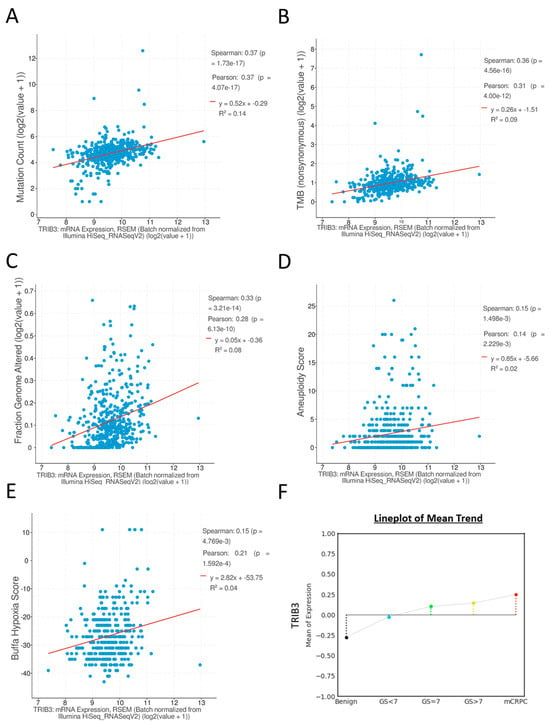
Figure 1
Open AccessArticle
Histone Arginine Methylation in the Kidneys of Rana sylvatica During Freeze–Thaw Cycle
by
Olawale O. Taiwo and Kenneth B. Storey
Kinases Phosphatases 2025, 3(1), 1; https://doi.org/10.3390/kinasesphosphatases3010001 - 7 Jan 2025
Abstract
►▼
Show Figures
Freeze tolerance is a remarkable adaptive trait exhibited by wood frogs (Rana sylvatica) during their hibernation period. To show the epigenetic mechanisms that contribute to kidney protection during freezing stress, this present study provides the first investigation of the role and
[...] Read more.
Freeze tolerance is a remarkable adaptive trait exhibited by wood frogs (Rana sylvatica) during their hibernation period. To show the epigenetic mechanisms that contribute to kidney protection during freezing stress, this present study provides the first investigation of the role and dynamics of histone arginine methylation and the expression of protein arginine methyltransferases (PRMTs) in a freeze-tolerant vertebrate. Kidney samples from three groups were assessed: (a) control frogs acclimated at 5 °C, (b) 24 h frozen frogs, and (c) 8 h thawed frogs. Our findings revealed significant downregulation of PRMT1, PRMT3, and PRMT5 in kidneys from frozen wood frogs compared to the control group. This downregulation indicates a potential role for PRMT enzymes in the regulation of arginine methylation under freezing stress. In addition, we observed distinct changes in histone marks. H3R17me2a showed significant upregulation after 24 h of freezing, potentially indicating its involvement in the activation of genes related to freezing survival. By contrast, H3R26me2a was downregulated after both 24 h freezing and 8 h thawing, whereas H3R8me2a showed sustained levels after freezing but was downregulated after thawing. These findings highlight the dynamic nature of histone arginine methylation and PRMT expression in wood frog kidneys during freezing–thawing. Our results indicate that epigenetic modifications play a crucial role in shaping the adaptive responses of wood frog kidneys to freezing stress and contribute new information on the underlying biochemical modifications that support vertebrate freeze tolerance.
Full article

Figure 1
Open AccessArticle
COSMC-Regulated O-Glycosylation: A Bioinformatics-Driven Biomarker Identification for Stratifying Glioblastoma Stem Cell Subtypes
by
Sara Sadat Aghamiri and Rada Amin
Kinases Phosphatases 2024, 2(4), 391-412; https://doi.org/10.3390/kinasesphosphatases2040025 - 22 Dec 2024
Abstract
►▼
Show Figures
Glioblastoma stem cells (GSCs) are key drivers of relapse, metastasis, and therapy resistance in glioblastoma due to their adaptability and diversity, which make them challenging to target effectively. This study explores the O-glycosylation in differentiating two key GSC subtypes, CD133 and CD44. We
[...] Read more.
Glioblastoma stem cells (GSCs) are key drivers of relapse, metastasis, and therapy resistance in glioblastoma due to their adaptability and diversity, which make them challenging to target effectively. This study explores the O-glycosylation in differentiating two key GSC subtypes, CD133 and CD44. We utilized the TCGA dataset of GBM and presented the reproducible bioinformatics analysis for our results. Our profiling showed enriched O-glycosylation signatures in CD44-expressing GBM cells over CD133, with Cosmc, the chaperone for core mucin-type O-glycosylation, significantly upregulated in the CD44-positive group. Moreover, Cosmc was associated with shorter progression-free intervals, suggesting its potential as an indicator of aggressive disease. High Cosmc expression also enriched immune-related pathways, including inflammatory response and antigen presentation, and was associated with presence of myeloid cells, T cells, and NK cells. Additionally, elevated Cosmc correlated with extracellular matrix (ECM) pathways and stromal cell populations, such as perivascular fibroblasts. These findings position O-glycosylation, specially, Cosmc as a promising biomarker for distinguishing GSC subclones, with relevance to immune modulation, and ECM dynamics, identifying it as a potential target for novel GBM therapies.
Full article

Figure 1
Open AccessArticle
Biochemical Properties of the Acid Ectophosphatase Activity of Phytomonas serpens Involved in Cell Proliferation
by
Luiz Fernando Carvalho-Kelly, Anita Leocadio Freitas-Mesquita, Thaís Souza Silveira Majerowicz and José Roberto Meyer-Fernandes
Kinases Phosphatases 2024, 2(4), 379-390; https://doi.org/10.3390/kinasesphosphatases2040024 - 15 Dec 2024
Cited by 2
Abstract
►▼
Show Figures
Phytomonas is the only kinetoplastid that can parasitize plants, causing economically relevant issues. Phytomonas serpens share similarities with pathogenic trypanosomatids, including surface enzymes that are involved in adhesion to the salivary gland of their experimental host, the insect Oncopeltus fasciatus. Ectophosphatases are
[...] Read more.
Phytomonas is the only kinetoplastid that can parasitize plants, causing economically relevant issues. Phytomonas serpens share similarities with pathogenic trypanosomatids, including surface enzymes that are involved in adhesion to the salivary gland of their experimental host, the insect Oncopeltus fasciatus. Ectophosphatases are cell surface enzymes involved in host–parasite interactions that are widely distributed among microorganisms. This work aimed to perform the biochemical characterization of P. serpens ectophosphatase activity, investigating and discussing its possible physiological role. This activity presented an acidic profile, and its kinetic parameters Km and Vmax were calculated as 1.57 ± 0.08 mM p-NPP and 10.11 ± 0.14 nmol p-NP/(h × 108 flagellates), respectively. It was stimulated by cobalt, inhibited by zinc, and insensitive to EDTA, a divalent metal chelator. The inhibitor sodium orthovanadate was able to decrease P. serpens ectophosphatase activity and growth, suggesting its involvement in cell proliferation. Given that P. serpens can uptake inorganic phosphate (Pi) from the extracellular medium, it is likely that its ectophosphatase activity acts together with the transport systems in the Pi acquisition process. The elucidation of the molecular mechanisms involved in this process emerges as a relevant perspective, providing new strategies for controlling Phytomonas infection.
Full article

Figure 1
Open AccessReview
Cyclic Peptides as Protein Kinase Modulators and Their Involvement in the Treatment of Diverse Human Diseases
by
Lorena Martínez-Alcantar, Laura Hernández-Padilla, Alma Laura Díaz-Pérez, Lizbeth Guadalupe Villalón-Magallán, Mayra Xóchitl Durán-Maldonado, César Díaz-Pérez, Marlene E. Campos-Morales, Citlali Figueroa-Guzmán and Jesús Campos-García
Kinases Phosphatases 2024, 2(4), 346-378; https://doi.org/10.3390/kinasesphosphatases2040023 - 12 Dec 2024
Cited by 1
Abstract
Protein kinases (PKs) are an important and very popular family of enzymes that play a vital role in regulating cellular processes via the phosphorylation of targets. Nevertheless, modifications in the expression due to mutations or their dysregulation can lead to diseases, including autoimmune
[...] Read more.
Protein kinases (PKs) are an important and very popular family of enzymes that play a vital role in regulating cellular processes via the phosphorylation of targets. Nevertheless, modifications in the expression due to mutations or their dysregulation can lead to diseases, including autoimmune disorders, cardiovascular problems, diabetes, neurological diseases, and cancers. Cyclic ultra-short peptides are amazing structures with unique properties. The cyclicity of cyclic peptides (CPs) can mimic the interactions between PKs and natural substrates, influencing the enzyme activity essential in health and disease physiology. Our review summarized that interference in the signal transduction mechanism of the PKs by CPs implies the inhibition of substrate phosphorylation at the level of the active site, similar to anti-neoplastic drugs. The remarkable capacity of CPs to interact with targets positions them as promising candidates for developing protein kinase inhibitors in treating diseases. This review offers new insights for CPs in molecular mechanisms, cytotoxicity, target selectivity, and the possibility of designing more effective and safe therapeutic agents.
Full article
(This article belongs to the Special Issue Human Protein Kinases: Development of Small-Molecule Therapies)
►▼
Show Figures

Figure 1
Highly Accessed Articles
Latest Books
E-Mail Alert
News
Topics
Topic in
Biology, Biomolecules, Cancers, Cells, IJMS, Pharmaceuticals, Kinases and Phosphatases
Kinases in Cancer and Other Diseases, 2nd Edition
Topic Editors: Jonas Cicenas, Anna M. CzarneckaDeadline: 31 August 2026

Conferences
Special Issues
Special Issue in
Kinases and Phosphatases
Human Protein Kinases: Development of Small-Molecule Therapies—2nd Edition
Guest Editor: Alison D. AxtmanDeadline: 30 August 2025
Special Issue in
Kinases and Phosphatases
Role of Protein Post-Translational Modifications in Cancer: Mechanisms and Therapeutic Opportunities
Guest Editors: Mauro Salvi, Wei-Chien Huang, Josefa LeónDeadline: 30 November 2025
Special Issue in
Kinases and Phosphatases
Past, Present and Future of Protein Kinase CK2 Research—2nd Edition
Guest Editors: Mauro Salvi, Maria RuzzeneDeadline: 30 November 2025






